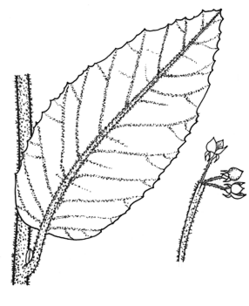Common name: Hazel Pomaderris
Pomaderris aspera Sieber ex DC. APNI* Synonyms: Pomaderris apetala Labill. APNI*

Description: Shrub to 4 m high, young stems densely rusty-tomentose, hairs stellate to dendritic.
Leaves mostly elliptic to lanceolate, mostly 5–20 cm long, 2–8 cm wide, margins ± toothed; upper surface usually sparsely stellate-hairy, rarely glabrous, dark green and strongly wrinkled between the deeply impressed veins; lower surface ± whitish with stellate hairs, at least the secondary veins rusty-hairy.
Flowers greenish yellow, in loose elongated panicles, 8–25 cm long. Petals absent.
Capsule mostly glabrous, hypanthium stellate-hairy, sepals persistent, recurved in fruit.
Distribution and occurrence: Widespread in moist forest, especially along streams in moist gullies in the ranges, chiefly south from Barrington Tops, also near Tenterfield, Tia Gorge and Ben Halls Gap S.F.
NSW subdivisions: NC, CC, SC, NT, CT, ST, CWS, SWS
Other Australian states: Vic. Tas.
This species has been confused with P. apetala, which has ovary and capsule stellate-hairy and a congested inflorescence <10 cm long. P. apetala s. str. is not found in N.S.W.
Text by G.J. Harden
Taxon concept: Flora of NSW 1 Suppl. (1999)
APNI* Provides a link to the Australian Plant Name Index (hosted by the Australian National Botanic Gardens) for comprehensive bibliographic data
***The AVH map option provides a detailed interactive Australia wide distribution map drawn from collections held by all major Australian herbaria participating in the Australian Virtual Herbarium project.
|


